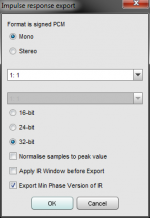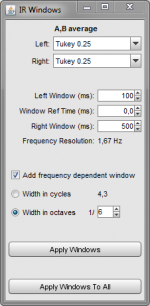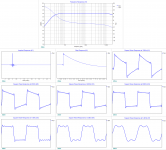Did you get the polarity and t=0 of the measurement right?
This is important to get the proper visualization of phase shifts and correct... correctly. They have been some advice in the previous posts that you should follow.
What phase corrections have you been using?
Regarding amplitude correction, you should only use minimum-phase ones, and as for the phase correction try to keep things simple. You don't want to correct measurement artifacts (position related, or windowing related...).
Phase and amplitude corrections done (properly) at different position can be "mixed" without problem.
Minimum-phase EQ should also help solving some phase variation, and eliminate the need for some phase EQs.
Not not hesitate to share you corrections and/or measurements.
Hello,
Here are some visuals of :
left and right measurements in REW. I have not done specific settings except calibration of the microphone and setup of asio devices. All my measurements and corrections are done at 96 Khz.
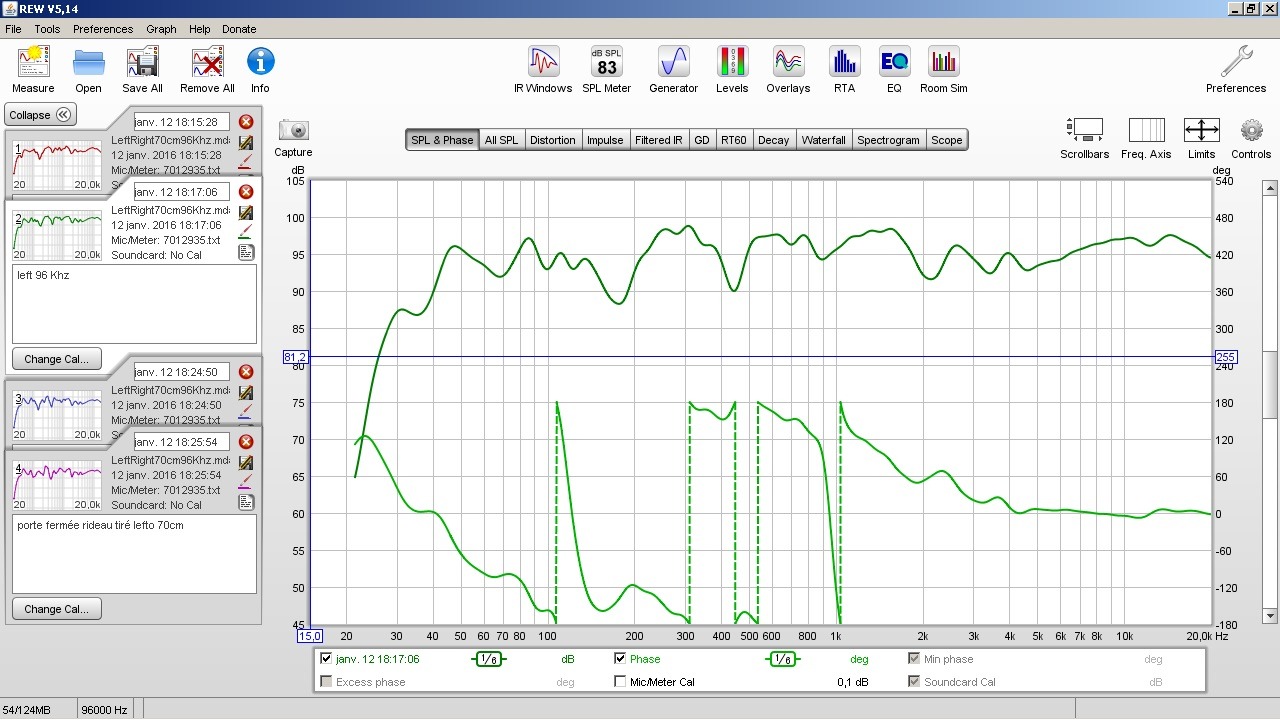
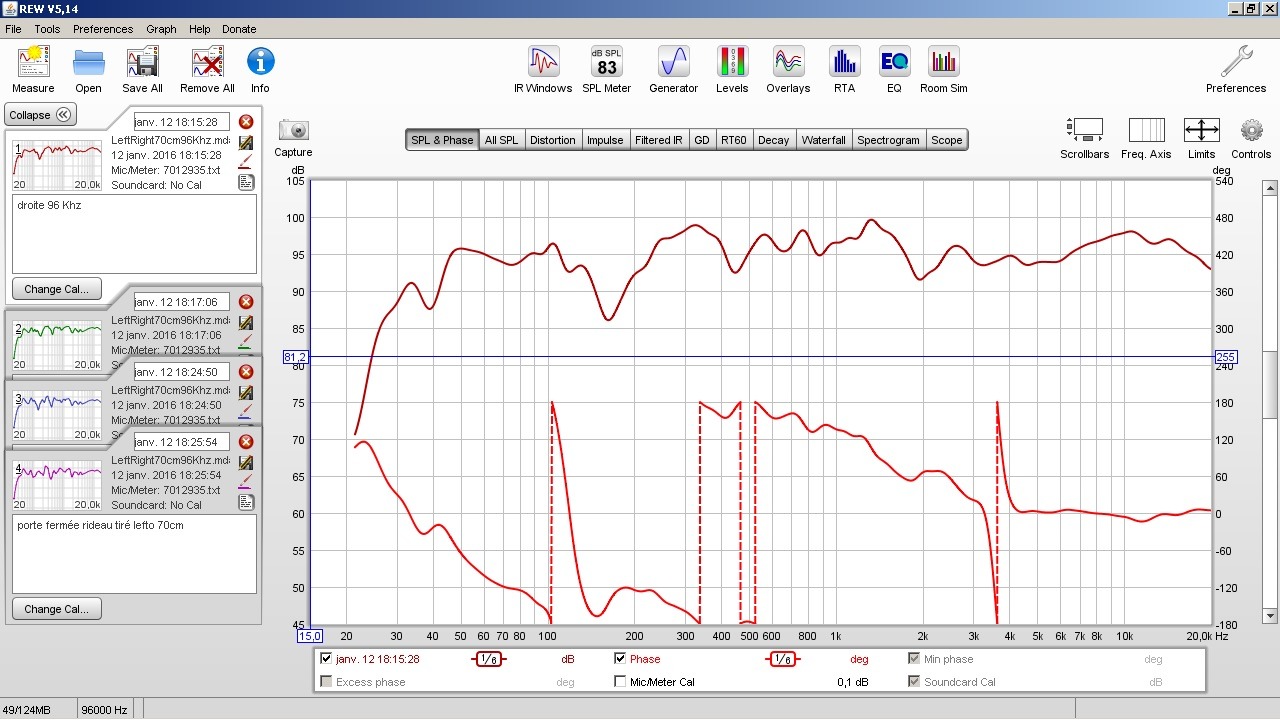
I did not touch settings with regards to polarity and timing.
Then usage of rephase for phase correction with those settings :
For the left channel :
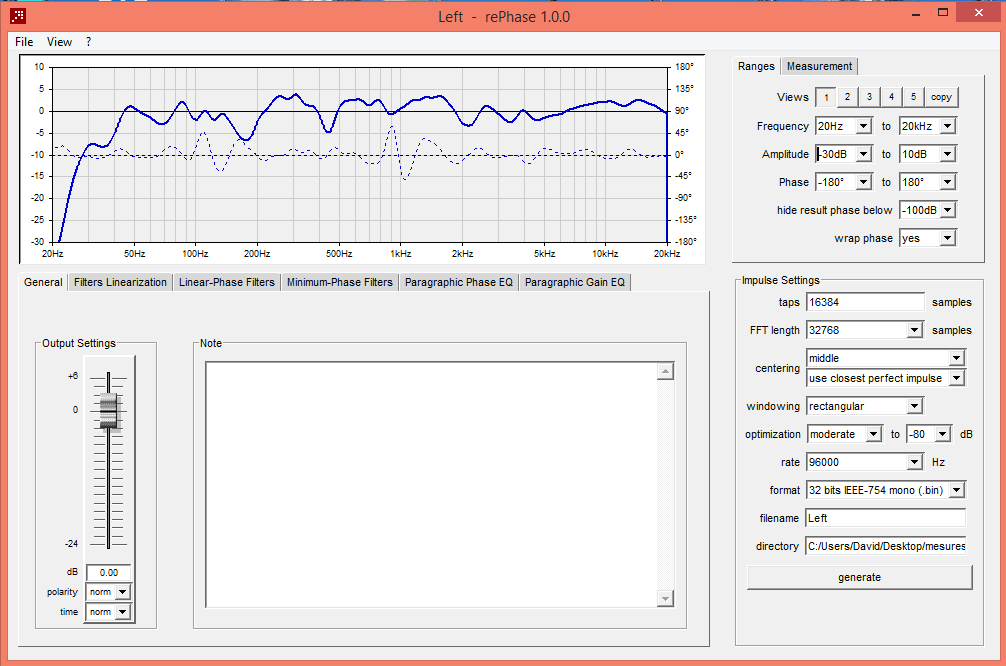
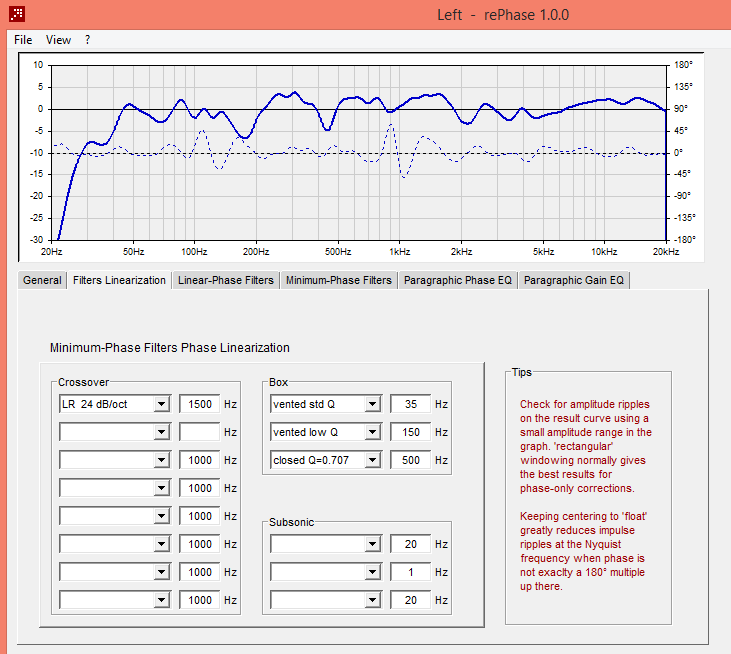
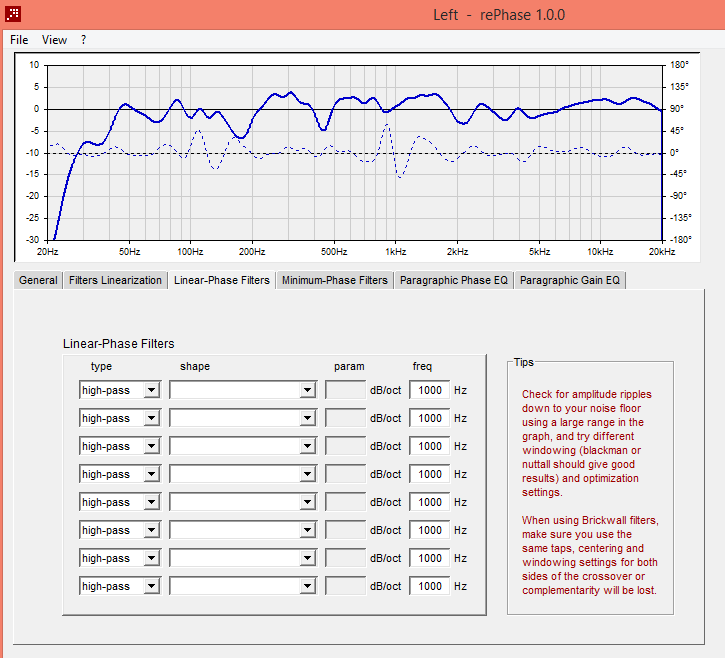
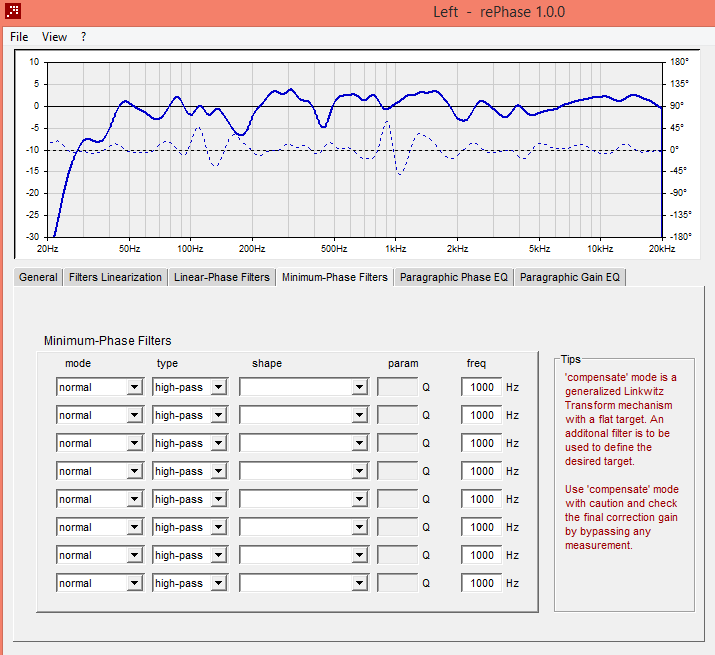
On this tab, I used 1/3 oct bands and corrected on the 3 of them
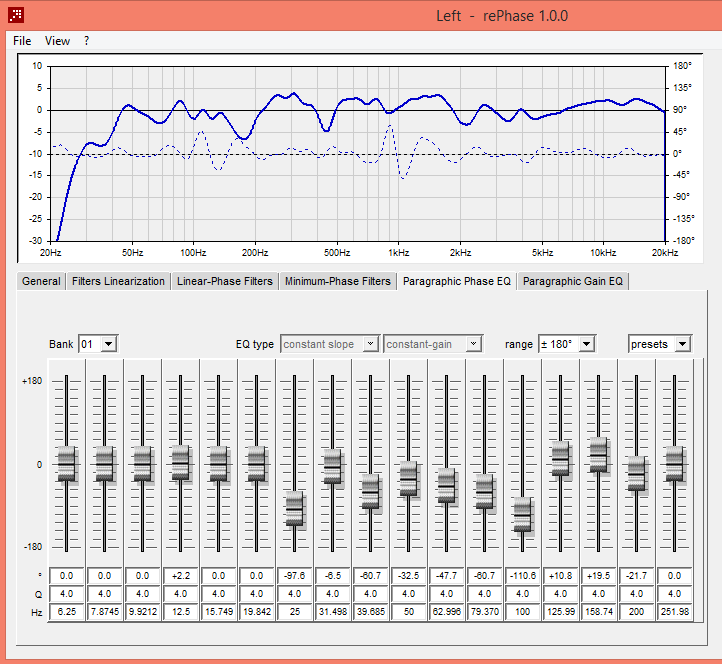
For the right channel :
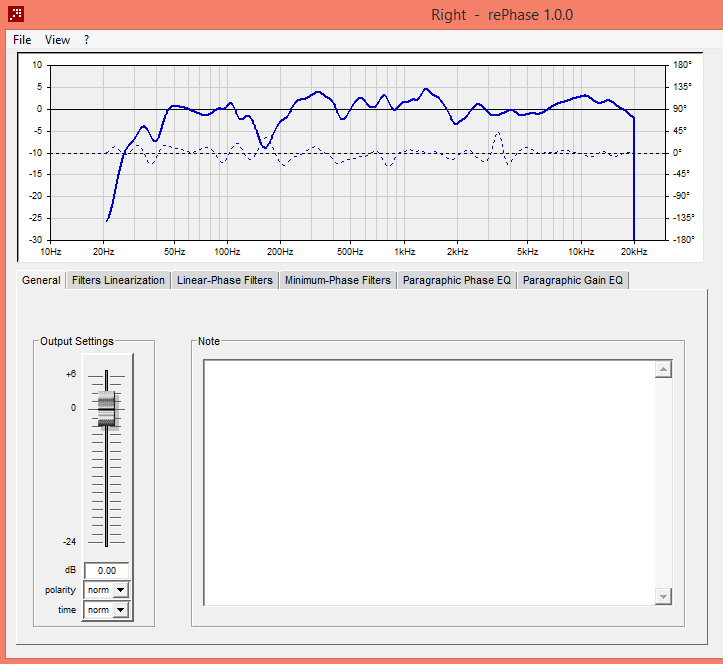
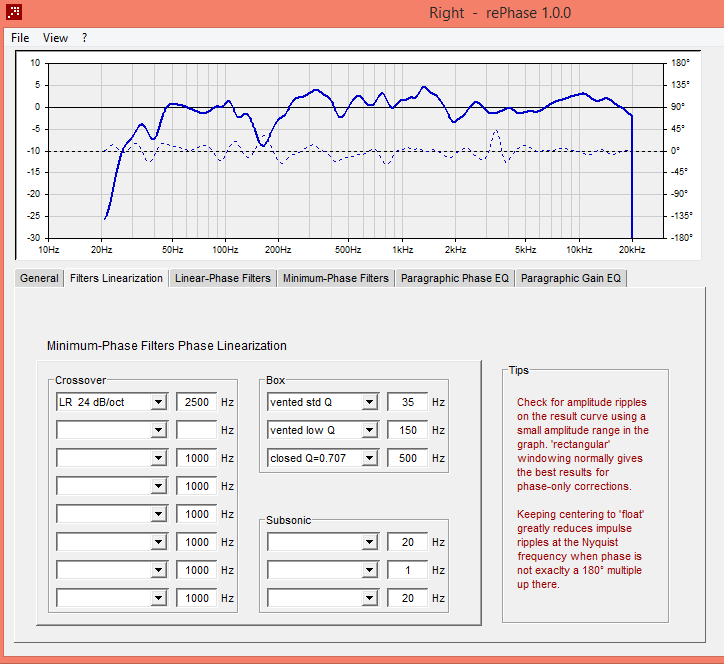
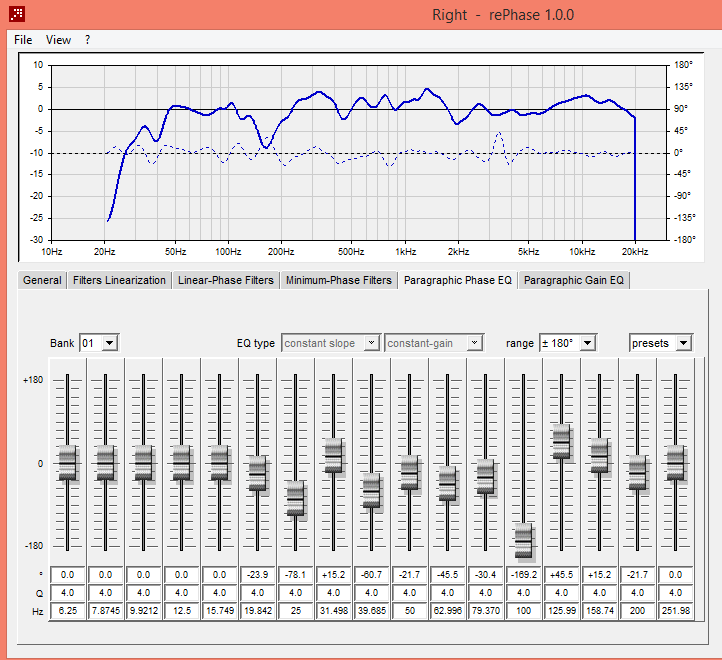
Filters are well exported with success to Daphile or Fedolight, but the results are not so much noticeable... I'm sure I might do something wrong.
Also looking at the wave form in Audacity, there seems to be very few elements in the wave. Is this normal ?

Many thanks for your help
David
Hello,
Here are some visuals of :
left and right measurements in REW. I have not done specific settings except calibration of the microphone and setup of asio devices. All my measurements and corrections are done at 96 Khz.
........
Many thanks for your help
David
Hi David,
Can you also provide REW measurements (SPL/phase) of the equalized loudspeakers at 70cm and 80cm?.
My apologies if you have already done so, but I somehow missed this - thanks.
Best Regards,
Bohdan
Hi Bodhan, if you mean their import in rephase before correction, there you go :
Thanks
David
Hi David,
No, that is not what I was asking for.
I was interested in SPL and phase after correction.
This measurement should be taken at two locations: (1) at the same distance as the original measurements and (2) 10-20cm further away.
You have also provided already Audacity screen shot of what seems to be an impulse response of the equalized loudspeaker - am I correct?.
If this is the case, please expand the Audacity screen to full size of your PC monitor screen and change vertical axis to Logarithmic. It is useful to evaluate IR in logarithmic scale.
Best Regards,
Bohdan
Hi David,
The JMR Cantabile are supposed to be filterd as:
" 6, 6 and 18 dB/octave
. Cut of frequencies 600 and
3800 Hz. The two woofers are working together
under 600 Hz. "
and can be seen like a two ways for xover.
If you look at global shape of the phase measurements, accidents free,( at 110 Hz ect ) it gives:

in rePhase ( time inverse ) just two settings: ( grosso modo ) to reach
the global shape, then some eq to add.

cdt
The JMR Cantabile are supposed to be filterd as:
" 6, 6 and 18 dB/octave
. Cut of frequencies 600 and
3800 Hz. The two woofers are working together
under 600 Hz. "
and can be seen like a two ways for xover.
If you look at global shape of the phase measurements, accidents free,( at 110 Hz ect ) it gives:

in rePhase ( time inverse ) just two settings: ( grosso modo ) to reach
the global shape, then some eq to add.

cdt
zizione, have you zero aligned IR those REW mesurements before export to frd-file to use in Rephase.
Here a couple of ways prepare in REW before export to frd-file, no claim these is the only and right way.
In general its worth after a new measurement look in both "Distortion" and "Impulse" windows as first thing after a new measurement sweep, if anything there looks weird and collapsed sweep again. Many has no problem but many setups show measurement chain trouple at some sweeps probably caused by environmental interferences and sample rate converting somewhere. Frq response often looks fine therefor look into the other two windows to see these sweep flaws.
1:
After a measurement or opening a old saved one view window in either "SPL & Phase" or "Impulse" plot then hit "Controls" and "Estimate IR Delay". Now export that as frd-file to be corrected in Rephase.
2:
Above will have phase plot that is speaker + room, this one will form phase as to be same minimum phase plot that is associated the actual frq response. First do same as point 1 except do not export as frd-file but export as "Impulse Response as Wav" as in below picture 1. Now import that IR-wav-file and zero align it with "Estimate IR Delay" command and its now ready to be exported as frd-file to be corrected in Rephase.
EDIT for point 2 after hit "Estimate IR Delay" then button above it "generate Minimum Phase" need be pushed too else one gets error pointing to this subject under the export as "Impulse Response as Wav" command.
3:
This is same as point 2 but add a frq dependent 1/6 oct 4,3 cycles window so as correction made in Rephase is more based first front wave than room. Procedure is before export frd-file as in point 2 ensure at left side that imported IR-wav file is high lighted then hit icon "IR Windows" and set it as in below picture 2 and hit button "Apply Windows". Now export that as frd-file to be corrected in Rephase.
In all three points above IR will be aligned but big difference is what measurement present to Rephase to correct for in time domain, so one must judge what will be most right if measurement is taken at 0,5-1,0 meter distance or at listening position and how much room is really present into measurement. Point 2 and 3 is inspired from another thread subject starts in link http://www.diyaudio.com/forums/full...eaker-correction-networks-21.html#post4548875.
Here a couple of ways prepare in REW before export to frd-file, no claim these is the only and right way.
In general its worth after a new measurement look in both "Distortion" and "Impulse" windows as first thing after a new measurement sweep, if anything there looks weird and collapsed sweep again. Many has no problem but many setups show measurement chain trouple at some sweeps probably caused by environmental interferences and sample rate converting somewhere. Frq response often looks fine therefor look into the other two windows to see these sweep flaws.
1:
After a measurement or opening a old saved one view window in either "SPL & Phase" or "Impulse" plot then hit "Controls" and "Estimate IR Delay". Now export that as frd-file to be corrected in Rephase.
2:
Above will have phase plot that is speaker + room, this one will form phase as to be same minimum phase plot that is associated the actual frq response. First do same as point 1 except do not export as frd-file but export as "Impulse Response as Wav" as in below picture 1. Now import that IR-wav-file and zero align it with "Estimate IR Delay" command and its now ready to be exported as frd-file to be corrected in Rephase.
EDIT for point 2 after hit "Estimate IR Delay" then button above it "generate Minimum Phase" need be pushed too else one gets error pointing to this subject under the export as "Impulse Response as Wav" command.
3:
This is same as point 2 but add a frq dependent 1/6 oct 4,3 cycles window so as correction made in Rephase is more based first front wave than room. Procedure is before export frd-file as in point 2 ensure at left side that imported IR-wav file is high lighted then hit icon "IR Windows" and set it as in below picture 2 and hit button "Apply Windows". Now export that as frd-file to be corrected in Rephase.
In all three points above IR will be aligned but big difference is what measurement present to Rephase to correct for in time domain, so one must judge what will be most right if measurement is taken at 0,5-1,0 meter distance or at listening position and how much room is really present into measurement. Point 2 and 3 is inspired from another thread subject starts in link http://www.diyaudio.com/forums/full...eaker-correction-networks-21.html#post4548875.
Attachments
Last edited:
Hi guys,
During the week-end, I have tested all methods. So far, I'm staying with Method 3 of BYRTT which provided the best improvement. It is quite amazing how deeper and clearer bass sounds, instruments are much more differentiated, space gained also a lot.
On complex messages like "Unsustainable" of Muse, everything is in place, and much clearer...
I'm going to continue a little bit my investigations, but I'm an happy guy right now...
Thanks Jmbee and BYRTT for your help
During the week-end, I have tested all methods. So far, I'm staying with Method 3 of BYRTT which provided the best improvement. It is quite amazing how deeper and clearer bass sounds, instruments are much more differentiated, space gained also a lot.
On complex messages like "Unsustainable" of Muse, everything is in place, and much clearer...
I'm going to continue a little bit my investigations, but I'm an happy guy right now...
Thanks Jmbee and BYRTT for your help
Thanks feedback zizione had a look at Jean-Marie Reynaud web site your speaker model CANTABILESUPREME looks great.
Glad to hear method 3 was a better one, credit should go to gmad and wesayso over that thread i just passed info. Actually haven't tried method myself yet but there is some logic in it works as a good base to make correction in Rephase especially for listening position scenario and full range speakers with frozen XO by that mean a speaker where we can't DSP control each driver by their own. Think measurement method ensure to some degree we get most speaker and less room and what wiggles can be linearized for a minimum phase speaker with IRR EQ correction at first before we finalize with FIR to correct for IRR XO points phase turn and or continue and also correct for hole IRR system stop bands roll off.
Think it can be discussed as personal taste if one prefer real linear phase correct for hole IRR system stop bands roll off, i ran this myself for many months but think they over that thread at present prefer that phase follow IRR associated frq response.
Should you want to try that receipt then when you measure your new corrected system hit "Estimate IR Delay" then "Generate Minimum Phase" and continue edit new corrections in Rephase with FIR power methode as jmbee tipped until measurement of corrected system show same minimum phase (IRR) trace as actual phase trace is. For fun made FR/IR/SR/square wave plots for a smooth IRR band pass system BW2 30Hz - BW2 22kHz if it runs 96kHz sample rate for correction and measurements to model your speakers specs. Think below show IRR pass band system can throw very fine waveform when we FIR correct only XO phase distortion away, it doesn't need linear phase all the way down from DC up to lightspeed to produce nice speaker grade square waves.
Have tried with method 1 in one spot around 1 meter distance linearize frq as smooth and wide as possible and then add as wide and linear phase as possible, sound over crazy good listening in that spot but acoustics is unfortunately not as a electric wire that only has one route so sound elsewhere is certantly not as should be.
Glad to hear method 3 was a better one, credit should go to gmad and wesayso over that thread i just passed info. Actually haven't tried method myself yet but there is some logic in it works as a good base to make correction in Rephase especially for listening position scenario and full range speakers with frozen XO by that mean a speaker where we can't DSP control each driver by their own. Think measurement method ensure to some degree we get most speaker and less room and what wiggles can be linearized for a minimum phase speaker with IRR EQ correction at first before we finalize with FIR to correct for IRR XO points phase turn and or continue and also correct for hole IRR system stop bands roll off.
Think it can be discussed as personal taste if one prefer real linear phase correct for hole IRR system stop bands roll off, i ran this myself for many months but think they over that thread at present prefer that phase follow IRR associated frq response.
Should you want to try that receipt then when you measure your new corrected system hit "Estimate IR Delay" then "Generate Minimum Phase" and continue edit new corrections in Rephase with FIR power methode as jmbee tipped until measurement of corrected system show same minimum phase (IRR) trace as actual phase trace is. For fun made FR/IR/SR/square wave plots for a smooth IRR band pass system BW2 30Hz - BW2 22kHz if it runs 96kHz sample rate for correction and measurements to model your speakers specs. Think below show IRR pass band system can throw very fine waveform when we FIR correct only XO phase distortion away, it doesn't need linear phase all the way down from DC up to lightspeed to produce nice speaker grade square waves.
Have tried with method 1 in one spot around 1 meter distance linearize frq as smooth and wide as possible and then add as wide and linear phase as possible, sound over crazy good listening in that spot but acoustics is unfortunately not as a electric wire that only has one route so sound elsewhere is certantly not as should be.
Attachments
Last edited:
Hi David,
The JMR Cantabile are supposed to be filterd as:
" 6, 6 and 18 dB/octave
. Cut of frequencies 600 and
3800 Hz. The two woofers are working together
under 600 Hz. "
and can be seen like a two ways for xover.
If you look at global shape of the phase measurements, accidents free,( at 110 Hz ect ) it gives:

in rePhase ( time inverse ) just two settings: ( grosso modo ) to reach
the global shape, then some eq to add.

cdt
Good job!By the way,rephase tool without any tutorial that regarding the import into different measurement platforms makes me hard to work with Arta
.I have not been able to save a measurement in the appropriate format in Arta.How to solve this problem?Thank you!
.I have not been able to save a measurement in the appropriate format in Arta.How to solve this problem?Thank you!
From Arta to rePhase, in the measurement window : file, export, ASCII file,
choose frd file, save and drop this file in rePhase window.
An externally hosted image should be here but it was not working when we last tested it.
Dear Thomas, how are you?I am happy these explanations could be of some use.
I ought to write some more serious documentation though...
One additional note: measurement polarity and time offset (t=0) is very important in order to get easy to deal with phase behavior (ie inline with the crossover theoretical behavior).
HOLM is quite good at finding t=0, but you need to have the polarity right first.
Having the first major peak positive and the t=0 cursor on that peak is a good start. That give you a phase that goes to 0° at Nyquist.
After applying minimum-phase EQ and compensating for the natural low pass of the driver you might have to recalibrate the time offset a little bit in the measurement tab in rephase, because the peak will have moved a bit...
When dealing with individual drivers (ie no crossover) you should never have to use phase EQ: during the "compensate" step (before applying actual linear-phase filters) a flat amplitude curve obtained with minimum-phase EQ should always give you a flat phase curve.
I continue to follow your posts here and elsewhere, always very very interesting. Many thanks for your willingness to help us.
You know that the impulse of a sub is quite difficult to interpret, many large waves of different height. Regarding the t=0 of a sub, where you to put the t=0? where the first wave start or at the peak of the 1st or 2nd wave? I would like to know your opinion
Ciao
GiAnt
Hello,
For a sub (and others bands),displaying impulse with log (dB) coordinate is helpful.
(due to energy who is spreaded in time,after t=0)
with a minimum phase measurement (without lin.phase low-pass and high pass).
t=0 must be placed at the beginning of the impulse.
For a sub (and others bands),displaying impulse with log (dB) coordinate is helpful.
(due to energy who is spreaded in time,after t=0)
with a minimum phase measurement (without lin.phase low-pass and high pass).
t=0 must be placed at the beginning of the impulse.
An externally hosted image should be here but it was not working when we last tested it.
Last edited:
Hi AntonelloDear Thomas, how are you?
I continue to follow your posts here and elsewhere, always very very interesting. Many thanks for your willingness to help us.
You know that the impulse of a sub is quite difficult to interpret, many large waves of different height. Regarding the t=0 of a sub, where you to put the t=0? where the first wave start or at the peak of the 1st or 2nd wave? I would like to know your opinion
Ciao
GiAnt
Thierry is right, you need a causal impulse (as with any measurement really).
You need to find the t=0 that gives you a minimum-phase behavior in (and around) the pass band.
The way I usually do it is by going for a "normal" t=0 on the peak, and then slowly decrease time offset in rephase until I get the expected (minimum) phase behavior.
You can use the "compensate" mode first to flatten the low pass, and then decrease time offset till you get a flat phase in the passband.
Anyway, once it is corrected you need to time align the sub in the crossover, and the easiest way to do this, once you have complementary low and high pass, is to use the reverse polarity trick and look for the deepest null...
It may sometimes help also to use "generate minimum phase" to check polarity, then, if needed, adjust t:0 to get the two curves as close as possible.
t= 0 will be at the very beginning of the impulse.
t= 0 will be at the very beginning of the impulse.
An externally hosted image should be here but it was not working when we last tested it.
It may sometimes help also to use "generate minimum phase" to check polarity, then, if needed, adjust t:0 to get the two curves as close as possible.
t= 0 will be at the very beginning of the impulse.
Can you explain how REW generates "minimum phase" phase response?.
Can you explain how REW generates "minimum phase" phase response?.
Hilbert's transform i guess .. not so accurate.
John K. told about that here:
http://www.diyaudio.com/forums/mult...e-linearization-eq-fir-filtering-tool-12.html
An externally hosted image should be here but it was not working when we last tested it.
- Home
- Design & Build
- Software Tools
- rePhase, a loudspeaker phase linearization, EQ and FIR filtering tool


